Leaf Surface Temperature and LED Grow Lights
Abstract
This paper demonstrates that plants grown under a plant-optimized ligting spectrum, as provided by some LED grow lights, may require warmer ambient air temperatures than identical plants grown under other lighting to achieve their full potential.
We performed an experiment comparing plant leaf surface temperatures under 8 equivalent LED, MH, HPS and fluorescent grow lighting fixtures in two different ambient air temperatures. Our results show that LED grow lights with a plant-optimized spectrum don’t heat plants’ leaves like every other form of artificial light we tested. Specifically, if plants are being grown in optimal conditions at 75 °F under HPS lighting, the ambient air temperature would need to be raised by 9 °F or more under LED plant lights to achieve the same optimal leaf surface temperature to optimize plants’ metabolism.
Ideal ambient growing temperatures are known for many plants when grown under long-used artificial lights such as High Pressure Sodium (HPS), Metal Halide (MH) and Fluorescent. All of these lighting technologies generate a significant amount of light wavelengths plants cannot efficiently utilize as an unintended byproduct of how they generate light. Unused light absorbed by a plant’s leaf will warm it up, affecting the ideal ambient growing air temperatures. LED grow lights are relatively new on the market and allow complete customization of the spectrum. LED lighting optimized for plant growth does not produce an excess of infrared, yellow or green light like other artificial grow light technologies, including “white” LEDs. Because leaves aren’t being directly warmed by these spectra that plants cannot use, plants grown under LED grow lights require warmer ambient air temperatures to achieve optimal metabolic rates.
The idealized, precise spectrum LED technology offers can significantly reduce cooling-associated costs by requiring warmer ambient growing conditions. This requirement also implies that side-by-side, identical-environment growing tests comparing plant-optimized LEDs with other artificial grow lights are unlikely to show the best results possible with plant-optimized LED grow lights, as plants require warmer air temperatures to achieve their full potential when grown under plant-optimized LEDs.
Introduction
This paper demonstrates that plants grown under an optimized spectrum as provided by LED grow lights may require warmer ambient air temperatures than identical plants grown under other lighting to achieve their full potential.
The complete environmental control enabled by growing indoors allows production of superior-quality plants. Achieving optimal results requires knowing and implementing ideal environmental conditions, of which there are many factors. One of the critical factors in achieving plants’ full potential is maintenance of optimal leaf surface temperatures through ambient air temperature control.
At Black Dog LED, we’ve observed that when employing LED lighting optimized for plant growth, ambient air temperature needs to be kept higher when compared to other types of artificial light to achieve the same optimal growth. By employing a forward-looking-infrared (FLIR) camera we can finally demonstrate what we’ve already experienced in our own growing by showing leaf surface temperatures under different kinds of lights in otherwise identical conditions.
Why does Leaf Surface Temperature (LST) Matter?
Most biochemical reactions only operate within a certain temperature range, and have an even narrower range in which the reaction proceeds most efficiently. If temperatures are too low or too high, the reactions proceed more slowly or not at all. Most of any plant’s metabolism occurs within the leaf; for any given plant, there is an optimal leaf surface temperature range that maximizes growth and production of other desirable secondary metabolites such as resins, pigments, flavor-enhancing compounds and vitamins.
Note that the leaf surface temperature (LST) is affected by, but not equivalent to the ambient air temperature in the growing environment. Leaves can be cooled through evaporation occurring in open pores in the leaf (stomata) that allow gas exchange, and are warmed by absorbed but unused light, whether from artificial or natural sources. Leaf surface temperature is almost always different than ambient air temperature.
What is the Ideal Leaf Surface Temperature?
So what is the ideal leaf surface temperature for plants? This is unfortunately a question without a single, simple answer as many factors influence the ideal.
Multiple types of metabolic reactions exist within every plant, and each has a different optimal temperature range. Primary metabolism (photosynthesis) is obviously the most important; without it the plant will not survive. Optimal temperatures for desirable secondary metabolites must be considered as well, especially if the plant is grown specifically for the secondary metabolites.
The optimal leaf temperature range for photosynthesis in many plants is between 15 °C and 30 °C (59 °F to 86 °F) for normal atmospheric concentrations of CO2. There are many exceptions; arctic- and alpine-adapted plants typically require cooler temperatures, while desert-adapted and plants using C4 photosynthesis prefer it warmer. (There are two slightly different chemical reactions for photosynthesis, called C3 and C4; the variant a plant uses is determined genetically.) CO2 supplementation will also generally raise the optimal photosynthesis temperature, so the ideal LST for photosynthesis is dependent on environmental conditions as well as the type of plant.
Secondary metabolic reactions can have a huge range of optimal temperatures; many plants have even evolved responses specifically triggered by exposure to cold or hot temperatures to better adapt to their surroundings. For example, some plants produce proteins with anti-freeze properties when exposed to cold.
In short, the ideal leaf surface temperature depends on the species / variety of the plant, overall environmental conditions, as well as what the plant is being grown for. Only experimentation can determine an ideal range for LST for a specific plant variety in a specific set of conditions.
What Affects Leaf Surface Temperature?
Many factors influence leaf surface temperature, such as the ambient air temperature surrounding the leaves, leaf pigmentation and genetic / metabolic differences. Higher relative humidity will likely increase leaf surface temperature in otherwise identical conditions, as evaporative cooling of the leaf will not occur as readily; plants employing CAM (Crassulacean Acid Metabolism) may be an exception, as their stomata (leaf pores) remain closed during the day. The amount of unused light absorbed by the leaf also has a profound effect, as it is converted to heat.
Various artificial grow light technologies create different light spectrums. LED grow lights differ significantly from other forms of artificial plant lights in that the spectrum can be tuned, eliminating unwanted excesses of light wavelengths (colors) while providing light plants can use most efficiently. Other artificial lighting technologies produce much of their light as an unintended and unavoidable byproduct of how they operate, ultimately wasting energy in heating up plant leaves.
When a photon of light hits a plant leaf, it can either be reflected or absorbed. Reflected photons will not affect the leaf temperature at all, but physics dictates that all photons absorbed by the leaf will increase the leaf temperature; how much depends on the energy (wavelength) of the photon and whether or not some of that energy was used to trigger other chemical reactions, such as photosynthesis. Photons fully utilized by the plant in chemical reactions will heat the leaf less than photons which are absorbed but not utilized. Therefore, measuring leaf surface temperature indirectly measures the efficiency of the light spectrum for growing plants– less-efficient spectrums will tend to heat the leaf more, while more-efficient spectrums will heat the leaf less as more of the light energy is being converted to chemical energy.
High Pressure Sodium (HPS) in particular converts a significant portion of the energy consumed by the light directly to non-visible infrared light in the 810-830nm range, peaking about 819nm. This infrared light is perceptible to you (and plants) by the warmth it creates when exposed to the light. Additionally, much of the visible light HPS bulbs produce is yellow and not highly-utilized by plants. This radiation not used for photosynthesis or other chemical reactions only serves to heat up the leaves, requiring cooler ambient temperatures to keep the plants’ leaves at their ideal temperature.
The Evidence
To demonstrate the affects of LED grow lights on leaf surface temperature compared to other forms of artificial lighting, we performed a simple experiment. In otherwise identical conditions, we measured leaf surface temperature for plants under various artificial lights and under an equivalent LED light at two different ambient air temperatures.
Setup
All testing occurred within our 12’x7.5′ environmentally-controlled, sealed growing chamber. A computer monitored multiple sensors, measuring temperature and managing humidity controls, ventilation and humidifiers to maintain stable environmental conditions. Oscillating fans providing brisk air movement are always running within the growing chamber, including for the duration of the testing.
6 different species of plants were selected for testing purposes, all adapted to full sunlight in nature:
- Averrhoa carambola (Carambola / Starfruit) is adapted to tropical and subtropical conditions.
- Garcinia xanthochymus (Yellow Mangosteen) is adapted to tropical and ultra-tropical conditions.
- Neoregelia hybrid (Bromeliad) is a plant using a CAM metabolism, and is useful in demonstrating the effect closed stomata have on LST under different conditions. The plant is naturally adapted to tropical and ultra-tropical conditions.
- Nicotiana benthamiana (Australian tobacco) is widely used in plant research, and is adapted to subtropical and temperate conditions.
- Ocimum basilicum (Basil) is widely adapted to tropical, subtropical and temperate conditions.
All plants were thoroughly watered and were placed so that the upper leaves for each specimen were all at the same height. The same individual plants, in the same position and orientation, were used for all of the tests to eliminate any possibility of differences between individual specimens.
Eight different artificial lights were tested:
- A 200-watt compact fluorescent bulb
- Used in a Hydrofarm Daystar reflector without tempered glass lens
- 6400K color temperature, “full spectrum daylight”
- A 240-watt Black Dog LED BD240-U light
- 15-color plant-optimized Phyto-Genesis Spectrum™
- Glass lens included
- A 240-watt all-white LED light
- Typical “white” LEDs consisting of a blue LED with a Yttrium-Aluminum-Garnet (YAG) phosphor
- 60% 2700K color temperature
- 40% 10000K color temperature
- Glass lens included
- Typical “white” LEDs consisting of a blue LED with a Yttrium-Aluminum-Garnet (YAG) phosphor
- A 324-watt T5 fluorescent fixture
- 6, 4-foot 54-watt T5 fluorescent bulbs
- 6500K color temperature, “full spectrum daylight”
- A 340-watt Black Dog LED BD360-U light
- 15-color plant-optimized Phyto-Genesis Spectrum™
- Glass lens included
- A 750-watt Black Dog LED Platinum XL-U light
- 15-color plant-optimized Phyto-Genesis Spectrum™
- Glass lens included
- A 1000-watt Hortilux Super HPS high pressure sodium bulb
- Used in a Hydrofarm Xtrasun 6 reflector with a tempered glass lens
- A 1000-watt Hortilux Blue metal halide (MH) bulb
- Used in a Hydrofarm Xtrasun 6 reflector with a tempered glass lens
These lights were chosen to represent a range of commonly-used artificial plant lights and to allow fair comparisons in terms of wattage and coverage area.
| Light | Wattage | Test Hanging Height | Coverage Area at Hanging Height |
|---|---|---|---|
| Comparable Small Lights | |||
| Compact Fluorescent | 200 | 13″ | 2.5′ x 2.5′ (6.25 ft2) |
| BD240-U (Phyto-Genesis Spectrum™) |
240 | 13″ | 2.5′ x 2.5′ (6.25 ft2) |
| All-white LED | 240 | 13″ | 2.5′ x 2.5′ (6.25 ft2) |
| Comparable Medium Lights | |||
| 6-bulb 4′ T5 fluorescent | 324 | 9″ | 2′ x 4′ (8 ft2) |
| BD360-U (Phyto-Genesis Spectrum™) |
340 | 14″ | 3′ x 3′ (9 ft2) |
| Comparable Large Lights | |||
| Platinum XL-U (Phyto-Genesis Spectrum™) |
750 | 24″ | 4.5′ x 4.5′ (20.25 ft2) |
| Metal Halide | 1000 | 24″ | 4.5′ x 4.5′ (20.25 ft2) |
| High-Pressure Sodium | 1000 | 24″ | 4.5′ x 4.5′ (20.25 ft2) |
Where equivalent plant-optimized LED lights were not available, we chose to compare LEDs of higher wattage to ensure the leaf surface temperature test was more than fair. For the 1000W HPS and MH bulbs, we chose the largest plant-optimized LED grow light on the market, the Black Dog LED Platinum XL-U, which covers an equivalent area and is marketed as replacing any 1000W HID bulb. In this case, the lower wattage of the LED light is due to the inherent efficiencies of LED technology– for example, not wasting energy creating light unusable to the plant.
For all tests, each light was allowed to fully warm up (run until the temperature of the light housing stopped increasing) with all of the test plants under the light. Relative humidity was maintained at 50%, plus or minus 3%.
A forward-looking infrared camera (a FLIR i7) was used to evaluate leaf surface temperature for each plant subject in each test. A StellarNet spectroradiometer was used to determine the spectrum of each light at the hanging distance.
Two tests were performed under each kind of light– first at 24 °C (75 °F) and next at 29 °C (84 °F). When ambient temperature was changed, at least 30 minutes was allowed before any readings were taken to allow the leaf surface temperature to come to equilibrium in the ambient conditions.
Ambient temperature and humidity were determined by sensors placed throughout the growing chamber that were not directly illuminated by the artificial light being tested. This is critical, as infrared and other light from the test lights can serve to warm up sensors and affect readings of temperature and relative humidity. To eliminate the possibility of other incidental lighting affecting the results, all other lights in the growing chamber were turned off– only the test light was running.
The HPS test was run almost a month before the other tests and the Nicotiana benthamiana plants did not exist, so we have no data for the high pressure sodium bulb for that plant. To ensure fair comparisons between the 1000W HPS, 1000W MH and 750W Platinum XL-U light, FLIR images were taken with the Platinum XL-U and each HID bulb on the same day, meaning the Platinum XL-U was tested twice.
Observed Leaf Surface Temperature for Averrhoa carambola (Carambola / Starfruit)
Small Light Comparison |
|
|---|---|
| BD240-U LED at 13″ (240W) | |
| 75 °F ambient room temperature | 84 °F ambient room temperature |
 |
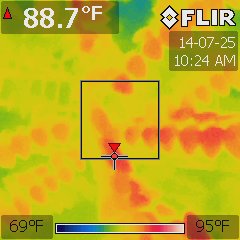 |
| All-white LED at 13″ (240W) | |
| 75 °F ambient room temperature | 84 °F ambient room temperature |
 |
 |
| Compact Fluorescent at 13″ (200W) | |
| 75 °F ambient room temperature | 84 °F ambient room temperature |
 |
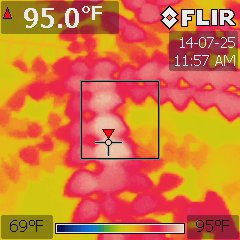 |
Medium Light Comparison |
|
| BD360-U LED at 14″ (340W) | |
| 75 °F ambient room temperature | 84 °F ambient room temperature |
 |
 |
| 4′ T5 6-bulb Fluorescent at 9″ (324W) | |
| 75 °F ambient room temperature | 84 °F ambient room temperature |
 |
 |
1000W MH versus LED Comparison |
|
|---|---|
| Platinum XL-U LED at 24″ (750W) | |
| 75 °F ambient room temperature | 84 °F ambient room temperature |
 |
 |
| Metal Halide at 24″ (1000W) | |
| 75 °F ambient room temperature | 84 °F ambient room temperature |
 |
 |
1000W HPS versus LED Comparison |
|
| Platinum XL-U LED at 24″ (750W) | |
| 75 °F ambient room temperature | 84 °F ambient room temperature |
 |
 |
| High Pressure Sodium at 24″ (1000W) | |
| 75 °F ambient room temperature | 84 °F ambient room temperature |
 |
 |
The 240W all-white LED increased leaf surface temperature more than the equivalent 240W BD240-U with a plant-optimized spectrum. Compact and T5 fluorescent lights both increased LST more than the equivalent 240W BD240-U and 340W BD360-U lights.
If this plant was being grown in optimal conditions (for an effective LST to optimize metabolism) when grown under HPS light at 75 °F, the ambient temperature would need to be raised by more than the experiment’s 9 °F to achieve the same leaf surface temperature.
It is worth noting that A. carambola folds its oppositely-arranged leaflets down when too warm, most likely as an adaptation to keep the leaves’ surface temperature in the ideal range and subequently reduce excess water loss. While difficult to discern in the false-color FLIR images, the test plant folded its leaves for both 84 °F tests under the 1000W MH and HPS lights, indicating the leaves were too warm.
Observed Leaf Surface Temperature for Garcinia xanthochymus (Yellow Mangosteen)
Small Light Comparison |
|
|---|---|
| BD240-U LED at 13″ (240W) | |
| 75 °F ambient room temperature | 84 °F ambient room temperature |
 |
 |
| All-white LED at 13″ (240W) | |
| 75 °F ambient room temperature | 84 °F ambient room temperature |
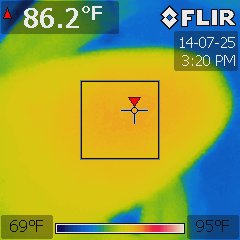 |
 |
| Compact Fluorescent at 13″ (200W) | |
| 75 °F ambient room temperature | 84 °F ambient room temperature |
 |
 |
Medium Light Comparison |
|
| BD360-U LED at 14″ (340W) | |
| 75 °F ambient room temperature | 84 °F ambient room temperature |
 |
 |
| 4′ T5 6-bulb Fluorescent at 9″ (324W) | |
| 75 °F ambient room temperature | 84 °F ambient room temperature |
 |
 |
1000W MH versus LED Comparison |
|
|---|---|
| Platinum XL-U LED at 24″ (750W) | |
| 75 °F ambient room temperature | 84 °F ambient room temperature |
 |
 |
| Metal Halide at 24″ (1000W) | |
| 75 °F ambient room temperature | 84 °F ambient room temperature |
 |
 |
1000W HPS versus LED Comparison |
|
| Platinum XL-U LED at 24″ (750W) | |
| 75 °F ambient room temperature | 84 °F ambient room temperature |
 |
 |
| High Pressure Sodium at 24″ (1000W) | |
| 75 °F ambient room temperature | 84 °F ambient room temperature |
 |
 |
Again, the 240W all-white LED increased leaf surface temperature more than the equivalent 240W BD240-U light. T5 and compact fluorescent light resulted in a higher LST than the equivalent 240W BD240-U or 340W BD360-U.
This plant exhibited a consistently higher LST relative to ambient air temperature under all lights than other tested non-CAM plants, possibly due to low stomatal density. It serves illustrate that no blanket statement such as “ambient air temperatures under LED lighting should be raised 9 °F compared to HPS to achieve the same LST” can be made– it depends on the physiology of the plant. In this case, ambient air temperatures would need to be raised more than 9 °F to achieve the same LST as HPS, although a 9 °F difference would be perfect compared to MH.
Observed Leaf Surface Temperature for Neoregelia hybrid (Bromeliad)
Small Light Comparison |
|
|---|---|
| BD240-U LED at 13″ (240W) | |
| 75 °F ambient room temperature | 84 °F ambient room temperature |
 |
 |
| All-white LED at 13″ (240W) | |
| 75 °F ambient room temperature | 84 °F ambient room temperature |
 |
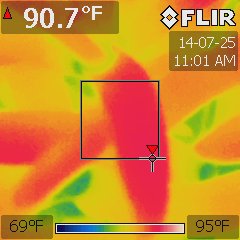 |
| Compact Fluorescent at 13″ (200W) | |
| 75 °F ambient room temperature | 84 °F ambient room temperature |
 |
 |
Medium Light Comparison |
|
| BD360-U LED at 14″ (340W) | |
| 75 °F ambient room temperature | 84 °F ambient room temperature |
 |
 |
| 4′ T5 6-bulb Fluorescent at 9″ (324W) | |
| 75 °F ambient room temperature | 84 °F ambient room temperature |
 |
 |
1000W MH versus LED Comparison |
|
|---|---|
| Platinum XL-U LED at 24″ (750W) | |
| 75 °F ambient room temperature | 84 °F ambient room temperature |
 |
 |
| Metal Halide at 24″ (1000W) | |
| 75 °F ambient room temperature | 84 °F ambient room temperature |
 |
 |
1000W HPS versus LED Comparison |
|
| Platinum XL-U LED at 24″ (750W) | |
| 75 °F ambient room temperature | 84 °F ambient room temperature |
 |
 |
| High Pressure Sodium at 24″ (1000W) | |
| 75 °F ambient room temperature | 84 °F ambient room temperature |
 |
Specimen plant was not subjected to HPS light at 84 °F ambient temperature, as it was already showing signs of burning at 80 °F.
|
This plant employs a CAM metabolism, and therefore had its stomata closed under all test conditions. While placed under the HPS light, the leaves started showing signs of burning as ambient air temperature approached 80 °F, and the plant was removed from the test as we didn’t wish permanent damage to our specimen plant. Without evaporative cooling enabled by open stomata, it appears that 84 °F is too high an ambient temperature to grow this plant under HPS lighting.
Yet again, the 240W all-white LED increased leaf surface temperature more than the equivalent 240W BD240-U light. T5 and compact fluorescent light resulted in a higher LST than the equivalent 240W BD240-U or 340W BD360-U.
Observed Leaf Surface Temperature for Nicotiana benthamiana (Australian Tobacco)
Small Light Comparison |
|
|---|---|
| BD240-U LED at 13″ (240W) | |
| 75 °F ambient room temperature | 84 °F ambient room temperature |
 |
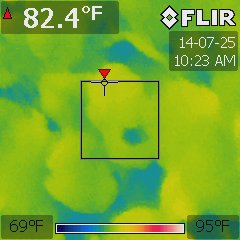 |
| All-white LED at 13″ (240W) | |
| 75 °F ambient room temperature | 84 °F ambient room temperature |
 |
 |
| Compact Fluorescent at 13″ (200W) | |
| 75 °F ambient room temperature | 84 °F ambient room temperature |
 |
 |
Medium Light Comparison |
|
| BD360-U LED at 14″ (340W) | |
| 75 °F ambient room temperature | 84 °F ambient room temperature |
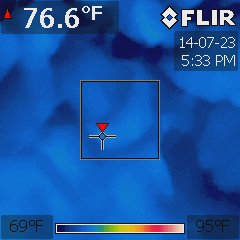 |
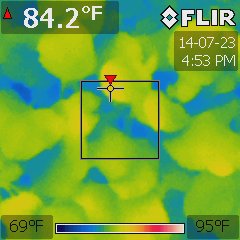 |
| 4′ T5 6-bulb Fluorescent at 9″ (324W) | |
| 75 °F ambient room temperature | 84 °F ambient room temperature |
 |
 |
1000W MH versus LED Comparison |
|
|---|---|
| Platinum XL-U LED at 24″ (750W) | |
| 75 °F ambient room temperature | 84 °F ambient room temperature |
 |
 |
| Metal Halide at 24″ (1000W) | |
| 75 °F ambient room temperature | 84 °F ambient room temperature |
 |
 |
This plant was not available for the high pressure sodium test, so no data was collected for high pressure sodium.
As with all plants shown so far, the 240W all-white LED increased leaf surface temperature more than the equivalent 240W BD240-U light. T5 and compact fluorescent light also resulted in a higher LST than the equivalent 240W BD240-U or 340W BD360-U.
Observed Leaf Surface Temperature for Ocimum basilicum (Basil)
Small Light Comparison |
|
|---|---|
| BD240-U LED at 13″ (240W) | |
| 75 °F ambient room temperature | 84 °F ambient room temperature |
 |
 |
| All-white LED at 13″ (240W) | |
| 75 °F ambient room temperature | 84 °F ambient room temperature |
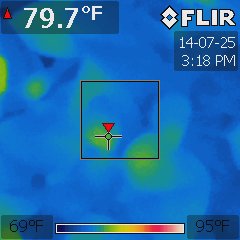 |
 |
| Compact Fluorescent at 13″ (200W) | |
| 75 °F ambient room temperature | 84 °F ambient room temperature |
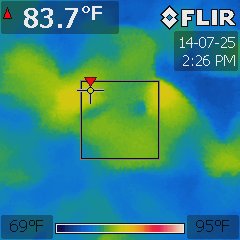 |
 |
Medium Light Comparison |
|
| BD360-U LED at 14″ (340W) | |
| 75 °F ambient room temperature | 84 °F ambient room temperature |
 |
 |
| 4′ T5 6-bulb Fluorescent at 9″ (324W) | |
| 75 °F ambient room temperature | 84 °F ambient room temperature |
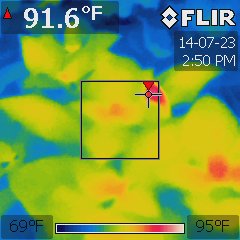 |
 |
1000W MH versus LED Comparison |
|
|---|---|
| Platinum XL-U LED at 24″ (750W) | |
| 75 °F ambient room temperature | 84 °F ambient room temperature |
 |
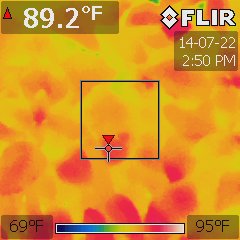 |
| Metal Halide at 24″ (1000W) | |
| 75 °F ambient room temperature | 84 °F ambient room temperature |
 |
 |
1000W HPS versus LED Comparison |
|
| Platinum XL-U LED at 24″ (750W) | |
| 75 °F ambient room temperature | 84 °F ambient room temperature |
 |
 |
| High Pressure Sodium at 24″ (1000W) | |
| 75 °F ambient room temperature | 84 °F ambient room temperature |
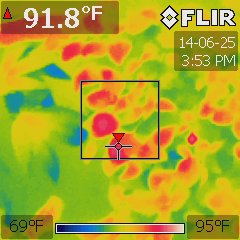 |
 |
The basil plant exhibited roughly the same leaf surface temperature under the 240W all-white LED as the equivalent 240W BD240-U light. T5 and compact fluorescent light still resulted in a higher LST than the equivalent 240W BD240-U or 340W BD360-U.
Basil exhibits roughly equivalent maximum LST with LED light at 84 °F as with HPS light at 75 °F, although the individual leaves seem to exhibit more consistent (and lower) temperatures under LED lighting.
Spectral Measurements
| Select Lighting Spectrums | ||||
|---|---|---|---|---|
| Black Dog LED Phyto-Genesis Spectrum™ | High Pressure Sodium | |||
| Compact Fluorescent | Metal Halide | |||
| All-White LED "Plant Light" | T5 Fluorescent | |||
| Graph Options |
|---|
| highlight closest spectrum to mouse |
| Select Additional Spectral Data | |
|---|---|
| Relative Photosynthetic Efficiency by Wavelength | |
Percent of Photons
This graphs the percentage of photons of a specific nanometer each light produces, relative to the total number of photons the light produces. For example, if 5 of every 100 photons the light puts off are in the 400-401nm range, the 400-401nm range in the graph will show 5%. This accurately portrays the percentage of energy each type of light is putting into creating a specific wavelength, in a way that can be directly compared with other lights. This eliminates any bias based on the total photon output of the light.
Experimental Conclusions
From the evidence we collected, it is apparent that ambient air temperature needs to be higher for plants grown under plant-optimized LED grow lights than for plants grown under HPS, MH, fluorescent or even white LED lighting to maintain the same leaf surface temperature, and hence the same potential metabolic rate. How much higher seems to be dependent on the physiology of the plant, which can vary significantly between species, somewhat among varieties, and perhaps even between individuals. However, the results for the majority of our test plants indicate that raising ambient air temperature approximately 9 °F to 10 °F results in an equivalent leaf surface temperature compared to growing the plant under high-power HPS and MH lights.
Implications
Optimizing Growth Under LED Grow Lights
When growing under optimized-spectrum LED plant lights, the lack of excess infrared and other unusable light causing the leaves to heat up means that ambient air temperature needs to be warmer than for the same plant grown under any light (natural or artificial) which is not optimized for plant growth.
Comparing LED Grow Lights to Other Grow Lighting Technologies
When growing with plant-optimized LED lights, it is important to realize that ambient air temperatures need to be kept higher compared to other lighting to achieve the same metabolic rate. Side-by-side tests of LED lights versus other lighting, where all other environmental conditions (such as ambient air temperature) are kept the same, are not particularly informative or accurate as to the lights’ relative performance– the tests should be run so that leaf surface temperature is being kept the same under each light to enable identical metabolic rates. As the data from our experiment shows, this becomes more critical especially when comparing plant-optimized LED grow lights to MH and HPS, as the leaf surface temperature difference is much higher with these lights.
Relative Energy Savings
Heat mitigation is required in most indoor gardens using artificial lights, whether it is achieved with ventilation or air conditioning. Properly-designed LED grow lights can offer substantial energy and cost savings in cooling. LED lights already contribute less heat to the growing environment than HPS, MH and fluorescent lights due to their reduced energy usage. Running a warmer indoor garden, as required for LED plant lights, leads to a profound reduction of costs associated with cooling– not just running the cooling equipment, but also in sizing it as well.
The energy and associated cost savings realized with LED plant lights go well beyond just the reduced electricity required to run the lights– in many situations the reduction in HVAC costs will easily be larger.
Even growing areas currently relying on excess heat from conventional grow lights can easily reduce cost with plant-optimized spectrum grow lights. In most indoor grow areas, insulation as simple as plastic sheeting can provide sufficient additional insulation to avoid the need for other forms of heat. In greenhouses, natural gas or propane heaters are usually much more cost-effective than electric heat.
The less electricity is spent creating heat, the less expensive a growing operation will be to run.
Other Savings
If grow room cooling is achieved partially or entirely through ventilation and CO2 supplementation is being used, the reduced need for cooling when using LED plant lights will result in less loss of CO2, reducing the need for replacement CO2, increasing savings.
Conclusion
By not wasting energy producing light of no use to the plant, LED grow lights are vastly more efficient than HPS and other traditional artificial plant lighting technologies. This has important implications on required environmental conditions to maintain optimal plant growth– plants grown under LED plant lights require a warmer environment.
Further Considerations and Reading
Reproducing This Experiment Yourself
If you are aiming to reproduce this experiment yourself, here are a few suggestions:
- Leaf surface temperature in otherwise-identical conditions can be greatly influenced by the thickness of leaves and their pigmentation level, which depend on the conditions an individual plant has been exposed to up to that point. Using the same exact plants for all conditions in the experiment eliminates the possibility of this natural variation affecting the results.
- Keep in mind that relative humidity affects how much evaporative cooling can cool the leaf, and that relative humidity is relative to the temperature. If you have 50% relative humidity in a 75 °F room and just heat the air up to 84 °F, the relative humidity will drop to 37%, and evaporative cooling will have a greater effect on leaf surface temperature.
- As you can see from our FLIR pictures, leaf surface temperature can vary significantly even within one leaf. Using an infrared thermometer to measure leaf surface temperature will only give the temperature at a single point. A FLIR camera gives you a better picture (literally) of the full temperature range over the leaves.
Estimating Savings from Reduced Cooling Needs
There are an incredible number of factors to account for when calculating the energy savings running a grow 9 °F warmer. Ambient outdoor temperature, insulation efficiency, cooling system efficiency and a host of other variables greatly affect the outcome. There are several convenient calculators on the internet for estimating energy savings in residential buildings based on higher thermostat settings, but these are based on assumptions about standard residential uses, and likely greatly underestimate the savings that would be realized in an artificially-lit indoor growing environment. Most residential rooms do not have kilowatts of lights actively heating the rooms, so it doesn’t take as much energy to maintain cooler temperatures.
Determining Optimal Leaf Surface Temperature
As stated earlier, it is difficult to determine optimal leaf surface temperatures in general due to the huge number of variables that can impact it. If you want to understand how to measure ideal photosynthetic rates for a plant and how they are affected by leaf surface temperature, check out this rather dense but very good article:
http://treephys.oxfordjournals.org/content/13/1/55.full.pdf+html
Still awake? There’s even more information about other considerations (from the same authors) here:
http://treephys.oxfordjournals.org/content/14/3/263.full.pdf+html
Note the Garcinia xanthochymus used in our tests is considered one of the possible parents of G. mangostana discussed in the article and likely exhibits similar characteristics, so the results may be somewhat applicable. It is interesting that the reported abnormally-low stomata occurrence rate for G. mangostana does concur with the observed relative heating of the G. xanthochymus leaves in our test– they performed similarly to the Neoregelia with completely closed stomata (due to bromeliads’ CAM metabolism). However, atmospheric pressure differences weren’t taken into account in the linked article, so your mileage may vary depending on altitude. And since their study plants were grown outdoors under natural (extremely variable) lighting, the results may not be applicable to plants adapted to more constant-light conditions, such as those experienced under artificial lighting.
It’s hard to accommodate for every possible environmental difference in any test. The authors of the linked article tried their best to account for everything to the point of becoming almost comically, impossibly complex; the plant-optimized spectrum offered by LED grow light technology found in the Black Dog LED Phyto-Genesis Spectrum™ offers yet another variable in determining the optimal temperature.
Please feel free to contact us at Black Dog LED with any questions!
